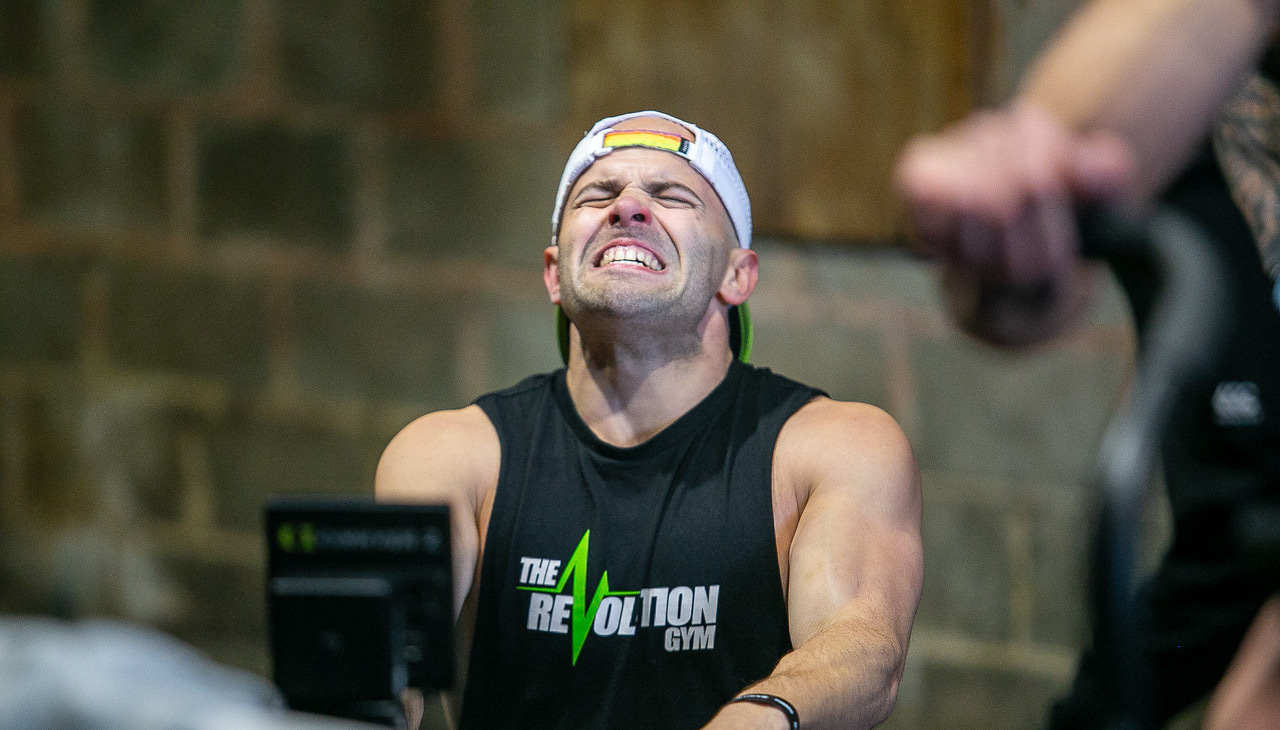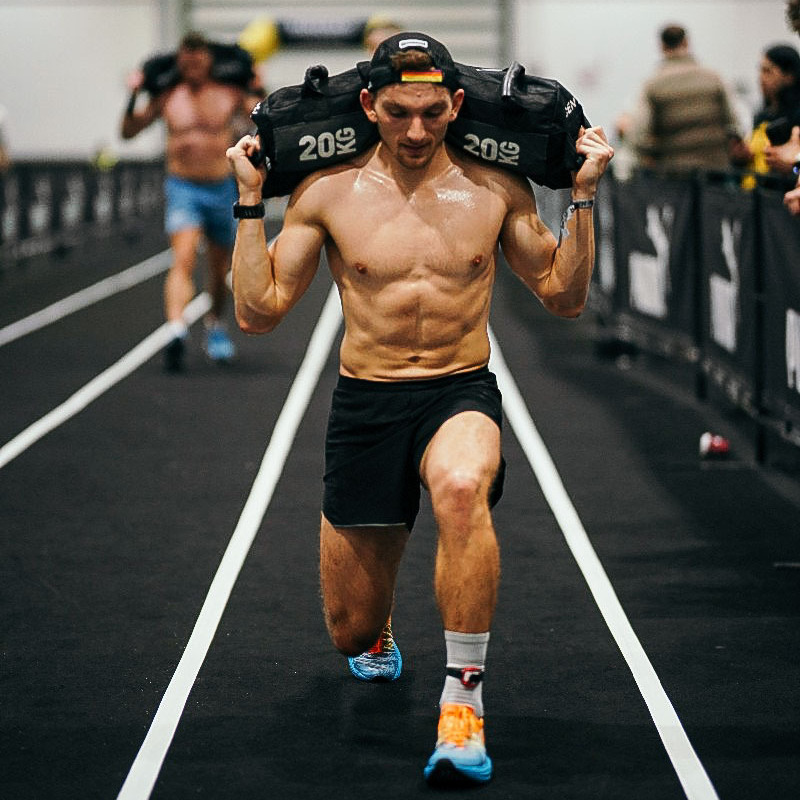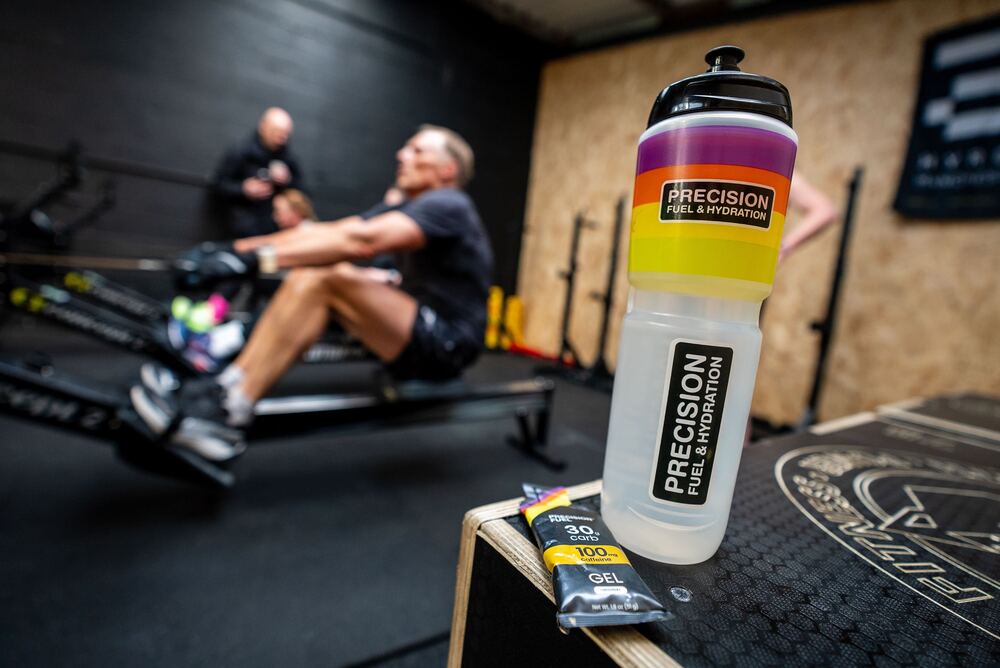HYROX arenas are a sweaty battleground of sled pushes, burpees and athletes who seem to have a t-shirt allergy 😜 In all seriousness, the high intensity effort required to complete a HYROX means it’s vital that you go into your races with a fuel and hydration strategy that’ll help you maintain your performance.
So, it’s no surprise that a growing number of HYROX competitors are reaching out to our Athlete Support Team for guidance on how to approach fueling their competitions…
Do you really need to fuel and hydrate a HYROX?
For the uninitiated, HYROX is a unique blend of endurance and strength, featuring eight rounds that each consist of a one-kilometre run followed by a functional workout station. Finish times range from ~55 minutes for the elites to around three hours for those grinding it out, with the ‘average competitor’ clocking in at just under 90 minutes.
Mel, from our Athlete Support Team, completed a HYROX race in 70 minutes and her average heart rate was 154bpm, which is ~96% of her maximum heart rate of 161bpm. That kind of sustained effort is comparable to running a half marathon or smashing out a sprint-distance triathlon, where glycogen stores are key to performance.
The constant switch between running and high-intensity efforts forces your body to toggle between aerobic and anaerobic metabolism, making carbohydrate availability crucial. Once your glycogen stores run low, fatigue kicks in, power output drops, and suddenly the rowing station starts to feel like a very long grind...

As well as burning through your glycogen stores, it’s likely that you’re going to be sweating a lot through those high intensity efforts. Inadequate fluid and sodium intake can result in progressive dehydration, leading to increased plasma osmolality, reduced blood volume, and impaired thermoregulation. This in turn can cause muscle cramping, decreased neuromuscular function, and cognitive decline.
So, replacing an adequate proportion of the fluid you lose through sweat (and the sodium you lose in that sweat) is very important to sustain your performance.
But before we consider how to approach fueling and hydration during a HYROX, it’s important to ensure you get to the start line in optimal condition…
How to START your HYROX fueled
Starting well-fueled is critical - providing your body with the energy it needs to sustain the hard efforts and delay fatigue. When fully stocked, your body can store ~500g of glucose as glycogen in your muscles, and ~100g in your liver, which is enough to fuel moderate to high-intensity exercise for ~60-90 minutes.
So, for most HYROX competitors, your glycogen stores serve as your primary energy source. If your glycogen levels are running low to begin with, fatigue will creep in, your strength and power output will be limited and your recovery between stations slowed down. Research shows that starting with “full” glycogen stores helps delay these issues so you can maintain a higher intensity across the entire event.
How to fuel the day before your event:
On a regular day, most people consume around 3-6 grams of carbohydrate per kilogram of body weight. However, for an event like HYROX, a more structured approach to carb-loading could be beneficial - especially if you expect to race for over two hours.
For most athletes, aiming for a minimum of 8g of carbohydrate per kg of body weight in the 24 hours leading up to the event helps ensure your muscle and liver glycogen stores are fully ‘stocked’.
How to fuel race morning:
A high-carb meal a few hours before your race helps maximise glycogen stores and ensures you start well-fueled. When it comes to pre-race food choices, stick to familiar, high-carb, low-fibre, and low-fat foods in the days leading up to and on race day to minimise the risk of GI discomfort.
Since the start time of HYROX competitions varies, the best approach is to work backwards from your start time to plan your pre-race nutrition:
- T- 2-3 hours: High-carb, low-fibre meal (e.g., toast, rice, porridge)
- T- 1-2 hours: Carb-rich snack (e.g., 1-2 x PF 30 Chew, energy bar, rice)
- T- 30 minutes: Another carb-rich snack (e.g., PF 30 Caffeine Gel, PF 30 Chew, energy bar, banana)
This approach helps ensure you hit the start line feeling primed, rather than running on fumes by station three.
How to START your HYROX hydrated
Many athletes unknowingly start events dehydrated, which can negatively affect both performance and perceived effort. A 2019 review found that 40-50% of recreationally active individuals begin exercise in a mildly dehydrated state. To optimise hydration, try preloading with a strong electrolyte drink like PH 1500.
Test out this preloading protocol before your longer and sweatier training sessions, so you’re confident of implementing it on race day:
- The night before: Drink 1 x PH 1500 tablet or packet with ~500ml (~16oz) of water
- 90 minutes before exercise: Drink 1 x PH 1500 tablet or packet with ~500ml (~16oz) of water to ensure you start fully hydrated
Electrolytes - especially sodium - play an important role in fluid balance, muscle function, and preventing cramping. Preloading increases plasma volume, which gives you a hydration ‘buffer’ so you can sweat from a larger 'pool' of fluid, tolerate more sweat loss before performance suffers, and sustain performance for longer..
Should you eat and drink DURING a HYROX?
Given HYROX events typically last between 1-3 hours, a strategic approach to your carb intake can help maintain your energy levels by delaying glycogen depletion.
Fuel Tips:
- If you’re racing for less than 75 minutes, carry some carb-rich gels or chews for quick energy boosts during the run or less intense moments. These can help top up energy levels without disrupting your rhythm
- Given that HYROX involves high-intensity strength and endurance efforts over an extended period, effectively training your gut to tolerate carbs is crucial. Optimising the gastrointestinal system’s ability to absorb and utilise fuel and fluids efficiently can help maintain hydration, sustain energy levels, and reduce the risk of gut distress. This ensures you can perform at high intensity without the discomfort or performance decline associated with poor nutrient absorption or dehydration
- You may want to consider using caffeine as 3-6mg of caffeine per kilo of body weight has been scientifically proven to enhance performance by reducing perceived effort and delaying fatigue. Given that caffeine has a half life of ~4-5 hours, it’s likely that a cup of coffee or caffeine hit via other means around an hour before your HYROX could give you that extra boost - especially for later start times, when tiredness from the day may already be kicking in

Hydration Tips:
With limited opportunities to grab fluids (and the risk of turning the arena into a slip 'n slide if you have a particularly high sweat rate), starting well-hydrated is your best bet.
- Studies have shown that more than a 2% loss of body weight from dehydration can reduce power output and impair cognitive function
- Where possible, sip water at the aid stations in the Rox Zone to manage thirst and minimise fluid loss
- Carrying a soft flask in your pocket or belt with some electrolytes can help maintain hydration and replenish sodium lost through heavy sweating (plus it’s easy to discard when empty)
How to fuel different race durations
Race duration: <75 minutes
- Focus on pre-event fueling to carry you through
- Eat a caffeine gel or chew in the final 30 minutes before your competition starts
- Carry an additional gel for a mid-race boost
- Sip water from aid stations if needed
Race duration: 75 minutes – 2 hours
- Eat a caffeine gel or chew in the last 30 minutes before the start
- Aim for 30–60g of carbs per hour using gels or chews
- Take them during easier sections or rest periods to avoid GI discomfort
- Carry a 500ml (16oz) soft flask of electrolytes to stay hydrated and replace lost sodium
Race duration: >2 hours
- Eat a caffeine gel or chew in the last 30 minutes before the start
- Aim for 30–60g of carbs per hour to prevent energy dips from glycogen depletion
- Carry a 500ml (16oz) soft flask of electrolytes to stay hydrated and replace lost sodium
- Take on additional fluid from aid stations as needed, particularly in humid environments
By fine-tuning your fuel and hydration strategy, you’ll keep your energy levels high, your power output steady, and your burpees looking (relatively) strong all the way to the finish.
Post-HYROX recovery
As tempting as it can be after a HYROX, recovery isn’t just about lying on the floor. A proactive approach to refueling and rehydrating can have a positive impact on how you’re able to bounce back from an event…
Fuel: Rebuild and Replenish
Refueling quickly will help repair damaged muscles and replenish your energy stores. A mix of simple carbohydrates, like glucose and fructose, helps restore both muscle and liver glycogen more efficiently. Delaying carbohydrate intake can negatively impact both recovery and subsequent performance, so don’t wait too long before getting food in.
- Research suggests that muscle damage from eccentric exercise (like those lung-burning sled pulls and wall balls) can impair muscle glycogen replenishment
- To counter this, aim for a high-carb meal with some protein soon after finishing (~60-80g of carbs and ~20-30g of protein)
- Continue prioritising carbs throughout the day and in the next 24 hours to optimise recovery
If you plan to train again soon, planning a more aggressive refueling strategy will help replace glycogen stores rapidly.
Hydration: Replace What You Lost
Most athletes finish HYROX dehydrated. PF&H COO, Jonny Tye carried out some sweat rate testing during his race simulation sessions and found that he loses 2-2.5L of sweat per hour. So, you’re basically leaving a small puddle of yourself behind. Replacing lost fluids with electrolytes, not just water, is key to recovering properly.
- High sweat rates are common in high-intensity events like HYROX, making rehydration with sodium crucial
- If you’re training again soon or have another race coming up, a more aggressive rehydration strategy is needed
- In these cases, drinking PH 1500 within 30-60 minutes post-HYROX will aid fluid retention, restore electrolyte balance, and help you recover faster

Finally, to give you an insight into how different athletes have fueled and hydrated their HYROX races, I’ve shared some case studies:
If you need help tailoring your plan for your HYROX race, you can book a free one-to-one video call with one of our team, or drop us an email at hello@fandh.com.
